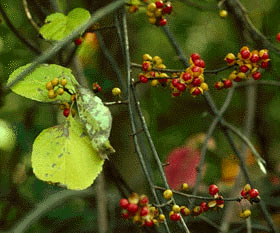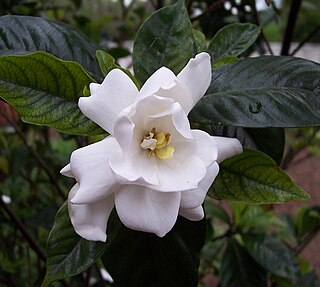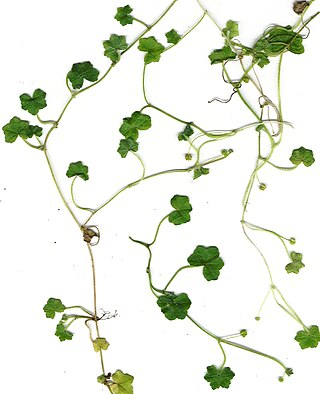
Magnolia is a large genus of about 210 to 340 flowering plant species in the subfamily Magnolioideae of the family Magnoliaceae. The natural range of Magnolia species is disjunct, with a main center in east and southeast Asia and a secondary center in eastern North America, Central America, the West Indies, and some species in South America.

Uncaria is a genus of flowering plants in the family Rubiaceae. It has about 40 species. Their distribution is pantropical, with most species native to tropical Asia, three from Africa and the Mediterranean and two from the neotropics. They are known colloquially as gambier, cat's claw or uña de gato. The latter two names are shared with several other plants. The type species for the genus is Uncaria guianensis.

Abutilon is a large genus of flowering plants in the mallow family, Malvaceae. It is distributed throughout the tropics and subtropics of the Americas, Africa, Asia, and Australia. General common names include Indian mallow and velvetleaf; ornamental varieties may be known as room maple, parlor maple, or flowering maple. The genus name is an 18th-century Neo-Latin word that came from the Arabic ’abū-ṭīlūn, the name given by Avicenna to this or a similar genus.

The Celastraceae are a family of 98 genera and 1,350 species of herbs, vines, shrubs and small trees, belonging to the order Celastrales. The great majority of the genera are tropical, with only Celastrus, Euonymus and Maytenus widespread in temperate climates, and Parnassia (bog-stars) found in alpine and arctic climates.

Gardenia is a genus of flowering plants in the coffee family, Rubiaceae, native to the tropical and subtropical regions of Africa, Asia, Madagascar, Pacific Islands, and Australia.

Melastomataceae is a family of dicotyledonous flowering plants found mostly in the tropics comprising c. 175 genera and c. 5115 known species. Melastomes are annual or perennial herbs, shrubs, or small trees.

Tripterygium wilfordii, or léi gōng téng (Mandarin), sometimes called thunder god vine but more properly translated thunder duke vine, is a vine used in traditional Chinese medicine.

Cynanchum is a genus of about 300 species including some swallowworts, belonging to the family Apocynaceae. The taxon name comes from Greek kynos and anchein, hence the common name for several species is dog-strangling vine. Most species are non-succulent climbers or twiners. There is some evidence of toxicity.

Hydrocotyle, also called floating pennywort, water pennywort, Indian pennywort, dollar weed, marsh penny, thick-leaved pennywort and white rot, is a genus of prostrate, perennial aquatic or semi-aquatic plants formerly classified in the family Apiaceae, now in the family Araliaceae.

Goniothalamus is one of the largest palaeotropical genera of plant in family Annonaceae.

Neotripterifordin is an anti-viral diterpene lactone isolated from Tripterygium wilfordii.

Triptofordin C-2 is an antiviral chemical compound isolated from Tripterygium wilfordii.

Tripchlorolide is an isolate of Tripterygium wilfordii (雷公藤) that has potential interaction with the NMDA receptor.

Tripdiolide is an anti-inflammatory isolate of Tripterygium wilfordii.

Triptolidenol is a bioactive diterpene created by Tripterygium wilfordii.

Dennstaedtia wilfordii is a species of fern in the family Dennstaedtiaceae. It was formerly placed in the monotypic genus Coptodipteris as Coptidipteris wilfordii. It is native from Pakistan through China to Korea and Japan.
Pseudonocardia rhizophila is a bacterium from the genus of Pseudonocardia which has been isolated from rhizosphere soil from the plant Tripterygium wilfordii in Yunnan in China.
Yang Dan is a Hong Kong-Chinese chemist and chemical biologist. She is the Chair Professor of Chemistry and the Morningside Professor in Chemical Biology at the University of Hong Kong. She was awarded the TWAS Prize for Chemistry in 2010 and the Young Woman Scientist Prize of China in 2011.
Stackebrandtia endophytica is an endophytic bacterium from the genus of Stackebrandtia which has been isolated from the stem of the plant Tripterygium wilfordii from Yunnan in China.

Triptonide is a chemical compound found in Tripterygium wilfordii, a plant used in traditional Chinese medicine. A 2021 trial in mice and monkeys suggested that triptonide may offer a reversible male contraceptive.

















